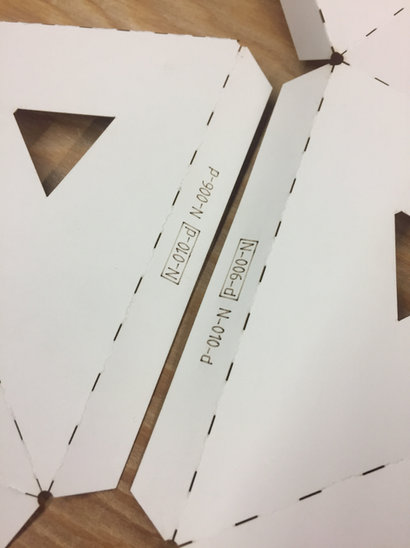top of page
CORALYTE
CORALYTE is a site specific installation designed, fabricated, and installed by Emergent Design for our Artisan's Asylum 30-day residency. CORALYTE creates a spatial experience that changes as you move through it, giving the sensation of being inside a coral ecosystem. Inspired by the skeletal remains of coral polyps, the proportions of CORALYTE were designed to bring a first person experience of coral to the human scale.






Computationally designed and digitally fabricated, the self-supporting structure is laser cut from 146 sheets of bristol paper, and is fully assembled without the use of glue, tape, or permanent fixtures - only binder clips. CORALYTE is over 13 feet tall and 17 feet wide. Through a simulated physics-based formfinding process, CORALYTE was designed such that each piece is in tension with each other, leading naturally to a structurally resilient form.

Play Video
CORALYTE is made up of over 1,400 paper strips of connected triangles, with more than 3,000 individual triangle faces and 2,000 binder clips. To manage these large numbers, we employed numerous computational and data management strategies. The overall form was broken into 20 subassemblies, and each subassembly was run through a Particle Swarm Optimization (PSO) process to generate the strips. This allowed us to maximize and minimize several variables concurrently: minimize the total number of strips, maximize the length of each strip, and guarantee no single-face strips.
Through a tabbing system we were able to join strips and subassemblies together. Each individual tab on every strip has a unique ID given from a system we developed specifically for this installation. This identification system allowed for complete assembly without reference to any 3D model or instruction sheet, meaning that we could enlist assembly help from people who had no knowledge of what they were building - they only followed the simple rules laid out by the system. Each tab identifies itself and its neighboring tab as follows: The tab references the subassembly ID A, the strip number 001, and the tab ID b, for a complete ID like A-001-b. This self-ID is etched with a box around it, and the neighbor tab is etched without.
A complete tab would look something like: [A-001-b] A-013-a meaning that this tab b on strip 001 in subassembly A connects to tab a on strip 013 in subassembly A. Once you know the rule of connection, anyone can construct this complex form without any visual reference.



The second visual layer of "petals" was also optimized. Although every triangle face is unique, there are only 3 typologies of petals. 264 small, 930 medium, and 203 large; all friction fit. We used size typologies so that we could easily cut and install the petals into each face without having more unique identifiers.












bottom of page



